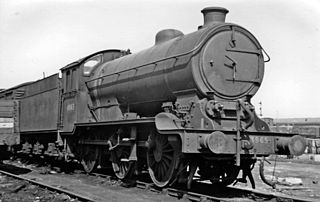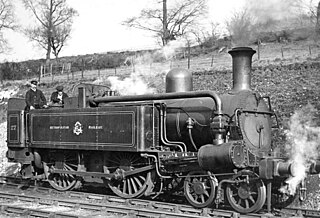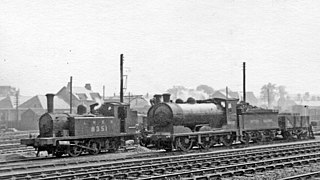John George Robinson CBE, was an English railway engineer, and was chief mechanical engineer of the Great Central Railway from 1900 to 1922.
The London and North Eastern Railway (LNER) produced several classes of locomotive, mostly to the designs of Nigel Gresley, characterised by a three-cylinder layout with a parallel boiler and round-topped firebox. It produced the most famous locomotive of its day, 4468 'Mallard', the holder of the world steam locomotive speed record. It also built the world-famous 4472 'Flying Scotsman'. However, its locomotive inheritance was much greater than just the 'A4 Class', it also produced highly successful mixed-traffic and freight designs.

The NBR C Class is a class of 0-6-0 steam locomotives designed by Matthew Holmes for freight work on the North British Railway (NBR). They were introduced in 1888 with inside cylinders and Stephenson valve gear. A total of 168 locomotives was built, of which 123 came into British Railways ownership at nationalisation in 1948. This was the last class of steam engine in service in Scotland.

The NBR K Class is a class of 4-4-0 steam locomotive of the North British Railway. The first batch was designed by Matthew Holmes in 1902 and had 6-foot-6-inch (1.981 m) driving wheels for express passenger work. Three more batches were designed by William P. Reid with 6-foot-0-inch (1.829 m) driving wheels for mixed traffic work. This included perishable goods, such as fish from Mallaig and Aberdeen. They had inside cylinders and Stephenson valve gear. The D34 locomotives, commonly known as Glen Class, were built with superheaters. The LNER later fitted superheaters to all D26, D32, and D33 engines as well. All engines of the K class are sometimes known as Glen Class, although the designation is strictly reserved to the fourth (D34) batch.
The Metropolitan Railway F class was a class of 0-6-2T side tank steam locomotive. They were based on the earlier E Class. Four locomotives, numbered 90 to 93 were built by Yorkshire Engine Company in 1901. They were later numbered L49 to L52.

The London and North Eastern Railway (LNER) Class J39 was a class of medium powered 0-6-0 steam locomotive designed for mixed-traffic work throughout the former LNER system between London and the north of Scotland.

The Great Central Railway (GCR) Class 9F was a class of 0-6-2T steam locomotive built between 1891 and 1901. From 1923 the locomotives were redesignated Class N5.
The Metropolitan Railway H Class consisted of eight 4-4-4T steam locomotives, numbered 103 to 110. They were built by Kerr, Stuart & Co of Stoke on Trent in 1920 at a cost of £11,575 each. A "notable addition" to the Metropolitan Railway, these locomotives were purchased for the express passenger trains on the mainline between Harrow —the change point from electric locomotives—and Aylesbury or Verney Junction.

The Metropolitan Railway K Class consisted of six 2-6-4T steam locomotives, numbered 111 to 116.

The Metropolitan Railway A Class and B Class were 4-4-0T condensing steam locomotives built for the Metropolitan Railway by Beyer Peacock, first used in 1864. A total of 40 A Class and 26 of the slightly different B Class were delivered by 1885. Used underground, the locomotives condensed their steam, and coke or smokeless coal was burnt to reduce the smoke.

Under the Whyte notation for the classification of steam locomotives, 0-8-4 represents the wheel arrangement of no leading wheels, eight powered and coupled driving wheels on four axles, and four trailing wheels on two axles.

The London and North Eastern Railway (LNER) D40 class is a type of 4-4-0 steam locomotive inherited from the Great North of Scotland Railway (GNSR). It consisted of GNSR class V and GNSR class F. The two classes were similar but the class F was superheated.

The Great Central Railway Class 8H was a class of 0-8-4T steam tank locomotives designed by John G. Robinson for hump shunting at Wath marshalling yard.

The Great Central Railway Class 8, known as the London and North Eastern Railway Class B5 following the 1923 Grouping, was a class of fourteen 4-6-0 steam locomotives designed to haul fast goods trains, in particular fish trains.
District Railway steam locomotives were used on London's Metropolitan District Railway. When in 1871 the railway needed its own locomotives, they ordered twenty four condensing steam locomotives from Beyer Peacock similar to the A Class locomotives the Metropolitan Railway was using on the route. As they were intended for an underground railway, the locomotives did not have cabs, but had a weatherboard with a bent-back top and the back plate of the bunker was raised to provide protection when running bunker first.
London's Metropolitan Railway (MR) amalgamated with other underground railways, tramway companies and bus operators on 1 July 1933, to form the London Passenger Transport Board (LPTB); the MR became the Board's Metropolitan line.
The SER Q class was a class of 0-4-4T steam locomotives of the South Eastern Railway. The class was designed by James Stirling and introduced in 1881.

The Great Central Railway (GCR) Class 9A was a class of 0-6-2T steam locomotive built between 1889 and 1892. From 1923 the locomotives were redesignated Class N4.

The first Metropolitan Railway steam locomotives were ordered in 1864 for the Metropolitan Railway, to replace the Great Western Railway locomotive that had opened their first line the previous year. A total of 116 locomotives were built, of which two survive in preservation.

The NBR F Class was a class of 0-6-0 tank locomotives, designed by William P. Reid on the North British Railway. They were used for dockyard shunting duties.











